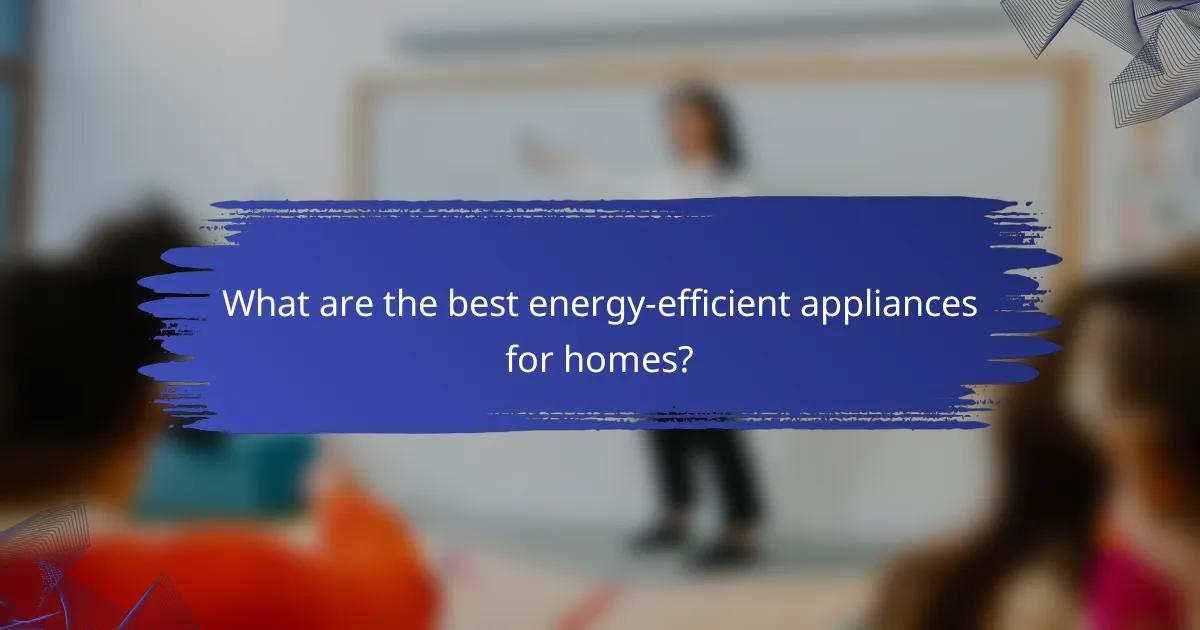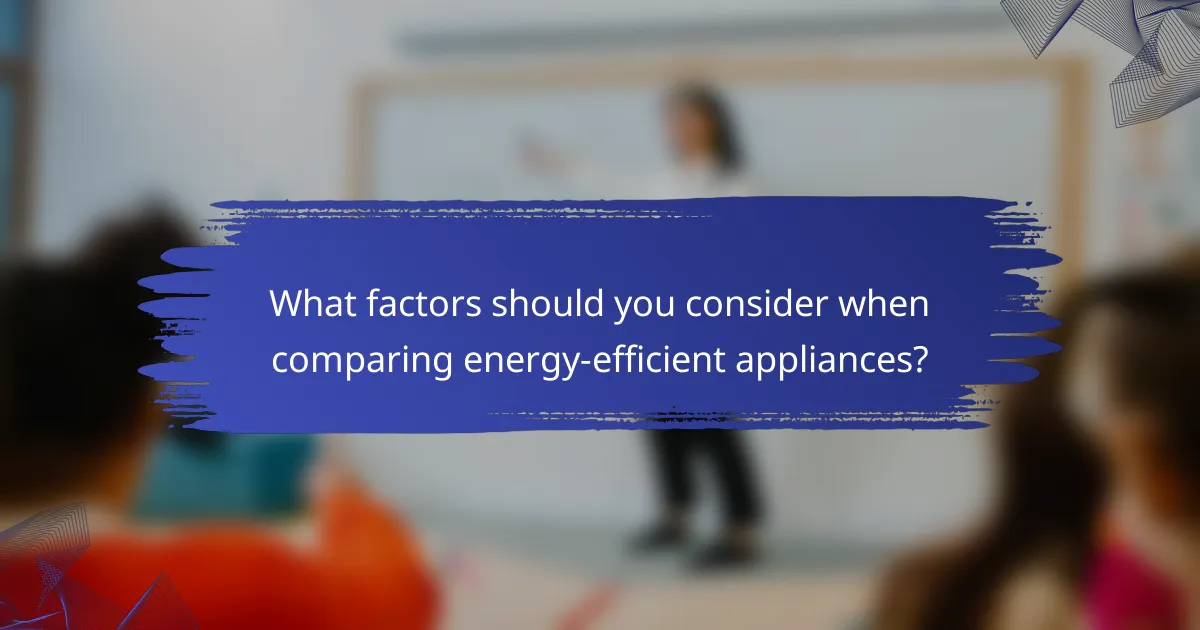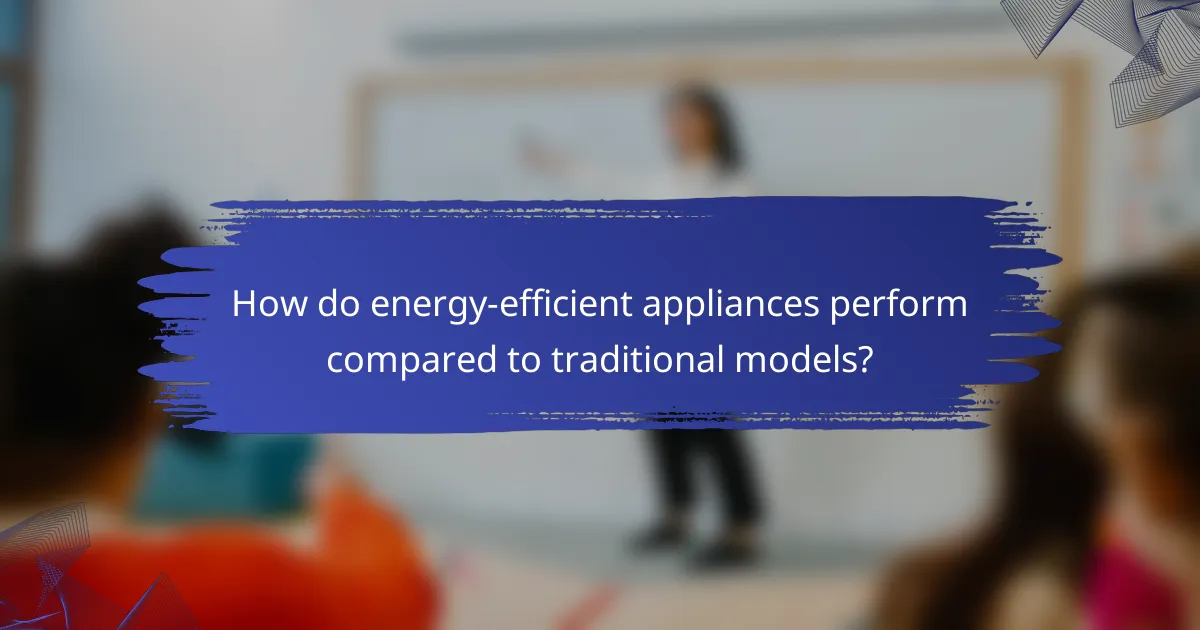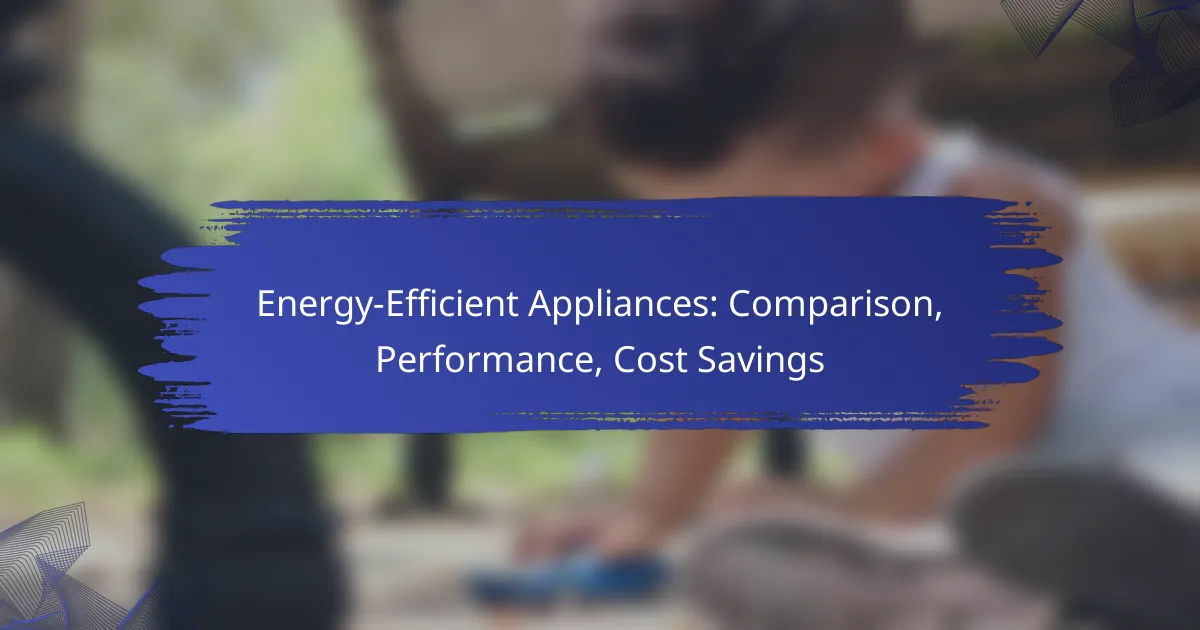Energy-efficient appliances are designed to minimize energy consumption while delivering optimal performance, making them an essential choice for eco-conscious homeowners. By opting for models such as Energy Star certified refrigerators and high-efficiency washing machines, consumers can significantly lower their utility bills and enjoy substantial long-term savings. When comparing these appliances, it’s important to consider energy ratings, purchase price, and brand reliability to ensure the best investment for your home.

What are the best energy-efficient appliances for homes?
The best energy-efficient appliances for homes include those that significantly reduce energy consumption while maintaining performance. Key options are Energy Star certified refrigerators, high-efficiency washing machines, LED lighting solutions, smart thermostats, and energy-efficient dishwashers.
Refrigerators with Energy Star certification
Energy Star certified refrigerators use about 15% less energy than standard models, making them a smart choice for energy savings. When shopping, look for models that have the Energy Star label, which indicates compliance with energy efficiency guidelines set by the U.S. Environmental Protection Agency.
Consider features like size and style, as larger units typically consume more energy. Additionally, models with top or bottom freezers are often more efficient than side-by-side designs.
High-efficiency washing machines
High-efficiency washing machines, often labeled as HE, use significantly less water and energy compared to traditional machines. They can save users hundreds of dollars on utility bills over their lifespan.
When selecting a washing machine, look for models that have a high Energy Factor (EF) rating, which indicates better efficiency. Front-loading machines generally offer better energy and water savings than top-loading models.
LED lighting solutions
LED lighting solutions are among the most energy-efficient options for home lighting, using up to 80% less energy than incandescent bulbs. They also last much longer, reducing replacement costs and waste.
When replacing bulbs, choose LEDs that match the brightness and color temperature you prefer. Look for Energy Star ratings to ensure you’re getting a quality product that meets efficiency standards.
Smart thermostats
Smart thermostats help optimize heating and cooling by learning your schedule and preferences, which can lead to significant energy savings. They can reduce energy consumption by up to 10-15% by automatically adjusting temperatures when you’re away.
When choosing a smart thermostat, ensure it is compatible with your HVAC system and consider features like remote access and energy usage reports. Some models also integrate with home automation systems for added convenience.
Energy-efficient dishwashers
Energy-efficient dishwashers use less water and energy than traditional models, often saving users money on utility bills. Look for Energy Star certified dishwashers, which typically use about 12% less energy than non-certified models.
When selecting a dishwasher, consider the capacity and features such as soil sensors and eco modes, which can further enhance efficiency. Regular maintenance, like cleaning filters, can also improve performance and longevity.

How do energy-efficient appliances save money?
Energy-efficient appliances save money primarily by consuming less electricity and water compared to standard models. This reduced consumption leads to lower utility bills and can result in significant savings over time.
Reduced energy bills
Energy-efficient appliances are designed to use less energy while maintaining performance. For instance, an energy-efficient refrigerator may use up to 50% less electricity than older models, translating to savings of around $100 annually on energy bills. These savings can vary based on local energy rates and the specific appliance type.
To maximize savings, consider using appliances during off-peak hours when energy rates may be lower. Additionally, look for the Energy Star label, which indicates compliance with energy efficiency standards.
Long-term cost savings
Investing in energy-efficient appliances often leads to long-term cost savings that exceed the initial purchase price. While these appliances may have a higher upfront cost, the reduced energy consumption can lead to savings of several hundred dollars over their lifespan. For example, a high-efficiency washing machine can save approximately $500 over ten years.
When evaluating long-term savings, factor in the lifespan of the appliance and its energy usage. Appliances with longer lifespans and lower energy consumption rates will yield greater savings over time.
Tax credits and rebates
Many governments offer tax credits and rebates for purchasing energy-efficient appliances, further reducing the overall cost. In the United States, for example, homeowners may qualify for federal tax credits when they buy Energy Star-rated appliances. These incentives can range from a few hundred to over a thousand dollars, depending on the appliance and local regulations.
Check with local utility companies and government websites for available rebates and tax incentives in your area. Taking advantage of these programs can significantly offset the initial investment in energy-efficient appliances.

What factors should you consider when comparing energy-efficient appliances?
When comparing energy-efficient appliances, consider energy consumption ratings, initial purchase price, brand reliability, and warranty options. These factors will help you evaluate the overall performance and cost-effectiveness of the appliances over their lifespan.
Energy consumption ratings
Energy consumption ratings indicate how much electricity an appliance uses during operation. Look for the Energy Star label or similar certifications, which signify compliance with energy efficiency standards. Appliances with lower energy consumption ratings typically lead to significant savings on utility bills.
For example, a refrigerator with an Energy Star rating may use up to 15% less energy than a standard model. This can translate to savings of around $50 to $100 annually, depending on local electricity rates.
Initial purchase price
The initial purchase price of energy-efficient appliances can vary widely. While these appliances often come with a higher upfront cost, they may offer long-term savings through reduced energy bills. Weigh the initial investment against potential savings over time.
For instance, an energy-efficient washing machine might cost $200 more than a conventional model, but it could save you approximately $100 in energy costs over five years. Consider your budget and how long you plan to use the appliance to make an informed decision.
Brand reliability
Brand reliability plays a crucial role in the longevity and performance of energy-efficient appliances. Research customer reviews and ratings to identify brands known for their durability and efficiency. Reliable brands often provide better performance and fewer maintenance issues.
Brands with a strong reputation may also offer better customer support and service, which can be beneficial if you encounter issues. Look for brands that consistently receive high ratings from independent testing organizations.
Warranty and service options
Warranties and service options are essential when selecting energy-efficient appliances. A robust warranty can protect your investment and provide peace of mind. Check the length of the warranty and what it covers, as this can vary significantly between manufacturers.
Some brands offer extended warranties or service plans that cover repairs and maintenance. Consider these options, especially for high-cost appliances, to ensure you are protected against unexpected expenses.

How do energy-efficient appliances perform compared to traditional models?
Energy-efficient appliances generally outperform traditional models in terms of energy consumption, leading to lower utility bills. They often incorporate advanced technologies that enhance their efficiency, providing similar or improved functionality while using less power.
Performance metrics
Performance metrics for energy-efficient appliances include energy consumption ratings, typically measured in kilowatt-hours (kWh) per year. For example, an energy-efficient refrigerator might consume 100-200 kWh less annually than a standard model, translating to significant savings over time.
Additionally, these appliances often have better performance ratings in terms of efficiency and effectiveness. For instance, energy-efficient washing machines may use less water and detergent while still delivering superior cleaning results.
Longevity and durability
Energy-efficient appliances are often built with higher quality materials and advanced technology, which can lead to increased longevity and durability. Many models come with warranties that reflect their expected lifespan, often ranging from 10 to 15 years.
Investing in energy-efficient appliances can reduce the frequency of replacements, ultimately saving money in the long run. However, it is essential to consider maintenance practices to ensure they operate efficiently throughout their lifespan.
Environmental impact
The environmental impact of energy-efficient appliances is significantly lower than that of traditional models. By consuming less energy, they contribute to reduced greenhouse gas emissions, which is crucial in combating climate change.
Moreover, many energy-efficient appliances are designed with recyclable materials, further minimizing their ecological footprint. Choosing appliances that meet recognized standards, such as ENERGY STAR, can help consumers make environmentally responsible choices.










